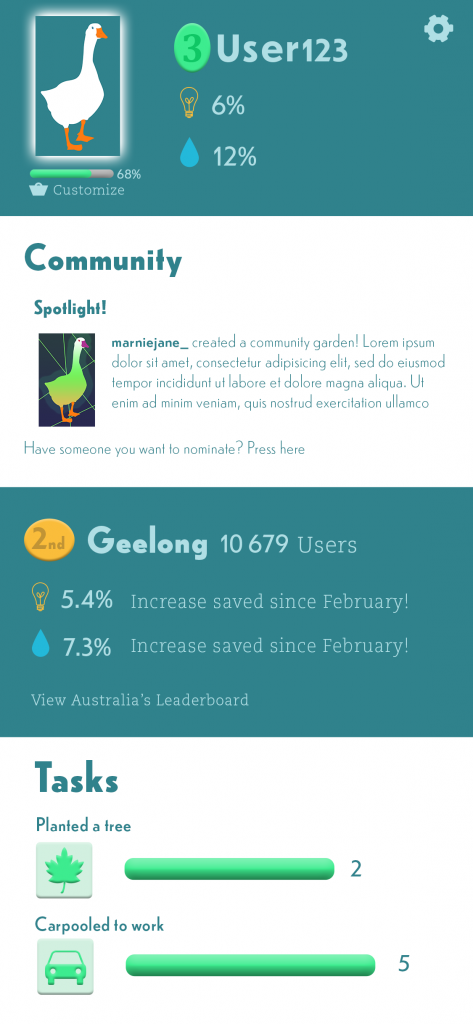While there is a comparative abundance of research on the effects of gamification in educational contexts, there is little considering the role of gamification in encouraging pro-environmental behaviour (Morganti et al. 2017). This topic, along with suggestions of functions for a pro-environmental behaviour gamified app will be explored.
Of the four pro-environmental behaviour interventions that Morganti et al. (2017) highlight, two specifically stand out as easily integrated into individual gamified systems. These are feedback and social approaches.

Customization!
Feedback and clear goals are key elements of gamification (McGonigal 2011) and are fundamental in gameplay and motivation (Bowman 1982; Malone 1981; Perry 2009; Provenzo 1991; Rieber 1996 cited in Morganti et al. 2017). In Siemens et al.’s (2015) study of progress feedback and intrinsic motivation in a marketing context, they identified feedback in the form of avatar creation was found to increase players enjoyment, effort, and flow, especially in games with a social aspect. That is, accomplishments equalling additional character customizations increase engagement (Siemens et al. 2015).
The idea of unlocking progressively sophisticated items, armour, costumes or clothing combines the social recognition and feedback system that badges offer, but the aesthetic is more prominent. Perhaps this mechanism can be incorporated into a an app for pro-environmentalism.
Morganti et al.’s (2017) review of ten studies involving gamified apps, serious games and pro-environmental behaviour revealed three central functions common to each app. These were environmental education, consumption awareness and energy efficiency behaviours (Morganti et al. 2017). Most of the results of the studies analysed produced an increase in positive environmental knowledge or behaviour in the participants (Morganti et al. 2017). My hypothetical gamified app includes all three elements.
Hypothetical gamified app (green goose)
I have devised an outline of my own hypothetical gamified app based on the findings of this research.
The app titled “green goose” contains three central functions and several periphery or optional features. The components contain social aspects, challenges, rewards, feedback, points, unlockable content, and competition/co-operation. The three mechanisms that Marganti et al. (2017) detailed as common for existing apps (environmental education, consumption awareness and energy efficiency behaviours) will be covered.
The three core functions are:
- Feedback in the form of tracking and usage data
- A system of logging pro-environmental behaviour
- A community or social dimension in which geographic areas are ranked.
Each user is represented by an avatar which will exhibit the likeness of a goose. The default beginner avatar is a plain, white-feathered goose but as the user accumulates rewards, they can choose to customize with accessories.

Levels. Together with a manual logging system and usage monitoring, users will accumulate progress towards a level. The progress will be added according to the percentage of increased energy or water preservation from one meter reading to the next, with points earned every time the user engages in pro-environmental behaviour (logged by the users themselves). As the points increase, the user levels up and is given access to greater customization of their avatar.
Another reward system will be unlockable knowledge. Tips and facts about pro-environmentalism will be rewarded as the user increases their level. By initially restricting access, there is an increased perception of value, which aims to entice the user to read and remember the information.
Competing towns. Users can see how their town compares against others around the country and view statistics of the town or suburb’s energy or water consumption, based on data from all users within that area. Users collectively work towards increasing the amount of energy and water consumption saved to achieve higher ranks each month.
The ‘spotlight’ feature highlights a user every week. Each community or geographical area will take part in nominating users and voting on them according to performance or if they have showcased a creative solution to a real-world problem. Their profile and avatar will be prominently displayed inside the app with a short summary of the achievement that caused them to win the spotlight.

In this image, the user’s stats are shown in a sticky top panel. As the user scrolls down, sections such as “community” and “Tasks” are revealed. The user can discover more information in these sections by tapping them.
The user’s progress towards each level is shown in a bar displayed beneath their avatar. They earn points towards each level by saving water and energy and logging tasks. Tasks are recorded by users tapping the buttons in the “Tasks” section.
What is not shown in this image is the information rewards feature. This could be its own section, revealed by scrolling further, or all these sections could be condensed into a menu – perhaps displayed at the bottom of screen with representative icons.
There will probably be further research coming. In the meantime, I encourage people to think about ways they can combine gamification and the environment to effectively solicit positive change.
I’m sure there are many other ideas! Comment your favourite feature, and more importantly, I challenge your to think of some more! I’ll add new ones at the bottom.
Additional ideas from comments:
.
.
References
McGonigal, J 2011, Reality is Broken: Why Games Make Us Better and How They Can Change the World. Penguin, New York, USA.
Morganti, L, Pallavicini, F, Cadel, E, Candelieri, A, Archetti, F, Mantovani, F 2017, ‘Gaming for Earth: Serious games and gamification to engage consumers in pro-environmental behaviours for energy efficiency’, Energy Research & Social Science, vol. 29, pp. 95–102, doi: 10.1016/j.erss.2017.05.001
Siemens, JC, Smith, S, Fisher, D, Thyroff, A & Killian, G 2015, ‘Level Up! The Role of Progress Feedback Type for Encouraging Intrinsic Motivation and Positive Brand Attitudes in Public Versus Private Gaming Contexts’, Journal of Interactive Marketing, vol. 32, pp. 1–12, doi: 10.1016/j.intmar.2015.07.001

